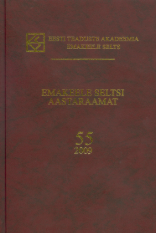ETUNIMED JA TEISED HARGLA HÜDRONÜÜMID
ANALYSIS OF THE HYDRONYMS IN HARGLA PARISH
Author(s): Mariko FasterSubject(s): Geography, Regional studies, Lexis, Finno-Ugrian studies
Published by: Eesti Teaduste Akadeemia Kirjastus
Keywords: toponyms; hydronyms; etymology; disappearance of hydronyms;
Summary/Abstract: The article provides an etymological and socio-onomastic analysis of 431 hydronyms which appear in the name stock of Hargla parish, located on the Estonian-Latvian language border. The material is derived from the database of place names of the historical county of Võrumaa and the toponym catalogue of the Institute of the Estonian Language. The article highlights 30 generic words which appear in the hydronyms of Hargla parish, and shows their regional peculiarities, e.g. special generics and distinctive developments in word meanings. The article also discusses the change and disappearance of hydronyms. The most common type of change is phonemic variation, partially because the region is bilingual (Estonian and Võro). In the analysis section, many previously unpublished etymologies are presented and previously known etymologies are further specified. The hydronyms are divided according to their etymology into five classes: 1. Transparent primary names (219 names), comprising linguistically understandable and clearly motivated names. Most of these have their roots in words related to nature. 37.5% of these names are today no longer in use. 2. Primary names for which the motivation is unclear, but which are lexically understandable (20 names). 30% of these names are today no longer in use. 3. Primary names which are linguistically obscure and difficult to etymologize (51 names). This group contains the oldest names, e.g. Koiva (Gauja), which is supposedly of Baltic origin, and Aheru järv, of Finnic origin. This group has seen the largest percentage of disappearing names, as 41.1% of the names denoting small objects have gone out of use. 4. Secondary names formed on the basis of other toponyms (119 names). Most of these are based on names of farmsteads, man-made objects or names of natural phenomena. 16.7% of them have disappeared. 5. Secondary names derived from personal names of either Latvian or Estonian origin (22 names). 19% of these names have disappeared. The study shows that the percentage of names that have disappeared is highest among primary names (36.2%) and much lower among secondary names (17.8%). According to Terhi Ainiala (1997: 239), roughly a quarter of hydronyms in Finland have disappeared. The percentage of disappearance of hydronyms in Hargla parish is 31%, which is, however, similar to two other parts of Estonia investigated by Alas (2015, 2016). The reasons for the disappearance of names include the emptying of villages and changes in the landscape (as in Finland as well), but also changes in the form of land use (from farmsteads to collective farms and back).
Journal: Emakeele Seltsi aastaraamat
- Issue Year: 2017
- Issue No: 63
- Page Range: 31-76
- Page Count: 46
- Language: Estonian

